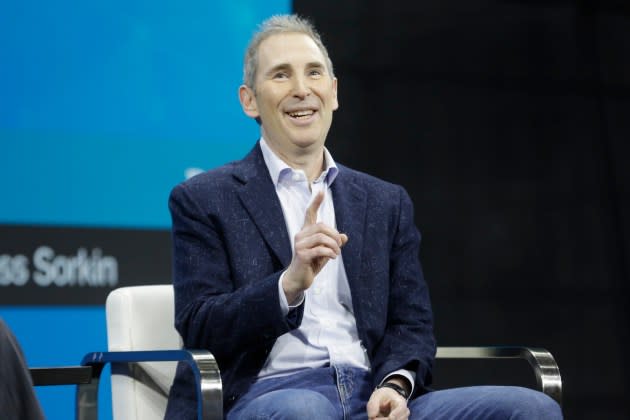Amazon CEO: ‘We’re Not Done’ Lowering Fulfillment Costs

Amazon has engineered significant cost cuts across its delivery network over the past year, but CEO Andy Jassy still believes there’s more to come.
“As we look toward 2024 (and beyond), we’re not done lowering our cost to serve,” said Jassy in his annual letter to shareholders. “We’ve challenged every closely held belief in our fulfillment network, and reevaluated every part of it, and found several areas where we believe we can lower costs even further while also delivering faster for customers. Our inbound fulfillment architecture and resulting inventory placement are areas of focus in 2024, and we have optimism there’s more upside for us.”
More from Sourcing Journal
Amazon, Walmart Called Out for 'Excessive' Warehouse Surveillance
Retail Tech: Blue Yonder's $839M Acquisition, CommentSold Launches PopClips
Amazon’s cost cutting began in early 2023 when the company restructured its U.S. fulfillment network into eight self-sufficient regional networks, so that product could travel shorter distances to the end consumer.
This has helped the e-commerce giant ultimately lower its “cost to serve”—which is the cost to get a product from Amazon to a customer—by more than 45 cents per unit in the U.S. compared to a year ago.
“Decreasing cost to serve allows us both to invest in speed improvements and afford adding more selection at lower average selling prices,” Jassy said. “More selection at lower prices puts us in consideration for more purchases.”
Jassy attributes Amazon’s wider success to its focus on creating what he called “primitive services,” which are foundational building blocks like Amazon Web Services (AWS) that facilitate innovation for the company.
One such primitive Jassy identified was the company’s 58 same-day fulfillment facilities, which have helped the tech titan increase the number of items delivered either same-day or overnight by more than 65 percent year over year in Q4.
“They’re located in the largest metro areas around the U.S., house our top-moving 100,000 SKUs (but also cover millions of other SKUs that can be injected from nearby fulfillment centers into these same-day facilities) and streamline the time required to go from picking a customer’s order to being ready to ship to as little as 11 minutes,” said Jassy. “These facilities also constitute our lowest cost to serve in the network. The experience has been so positive for customers that we’re planning to double the number of these facilities.”
But Jassy believes the same-day facilities have a lot more potential to improve areas like Amazon’s seemingly experimental grocery business, particularly for delivering organic products from Whole Foods Market or non-perishable goods such as canned goods and health and beauty products.
“We’ve been working hard on building a mass, physical store offering (Amazon Fresh) that offers a great perishable experience; however, what if we used our same-day facilities to enable customers to easily add milk, eggs or other perishable items to any Amazon order and get same day?” Jassy questioned. “It might change how people think of splitting up their weekly grocery shopping, and make perishable shopping as convenient as non-perishable shopping already is.”
Jassy also acknowledged the recent hiccups seen in expanding its drone capabilities, with the company’s Prime Air drone division seeing setbacks due to government regulations, layoffs and top team members leaving the unit.
But he doesn’t appear to be backing off the commitment for the long run. Upon saying the drones were “making substantial progress,” Jassy said the service would be “a very valuable future primitive capability” for Amazon.
“Drones will eventually allow us to deliver packages to customers in less than an hour. It won’t start off being available for all sizes of packages and in all locations, but we believe it’ll be pervasive over time,” Jassy said. “Think about how the experience of ordering perishable items changes with sub-one-hour delivery?”
The CEO also talked up Amazon’s robotics team, which has introduced new tests in recent months that have further cut metrics like inventory identification time or order processing time across multiple warehouses.
Such investments cost a pretty penny for Amazon. On the same day Jassy published his shareholder letter, the company announced it will have spent 700 million euros ($744 million) on robotics deployments in Europe alone over the past five years by the end of 2024.
In that time, Amazon deployed more than 1,000 robotics systems across its European fulfillment center network. The company expects to introduce 120 new pieces of automation technologies in 2024.
“Some of the biggest opportunities require invention in domains such as storage automation, manipulation, sortation, mobility of large cages across long distances and automatic identification of items,” said Jassy in his letter. “Our robotics team has built primitives in each of the above domains that will be lynchpins in our next set of automation, which includes multi-floor storage, trailer loading and unloading, large pallet mobility and more flexible sortation across our outbound processes (including in vehicles).”
Jassy also lauded the robotics team is also building a set of foundation AI models to better identify products in complex environments, optimize the movement of its robotic fleet and better manage the bottlenecks in its facilities.